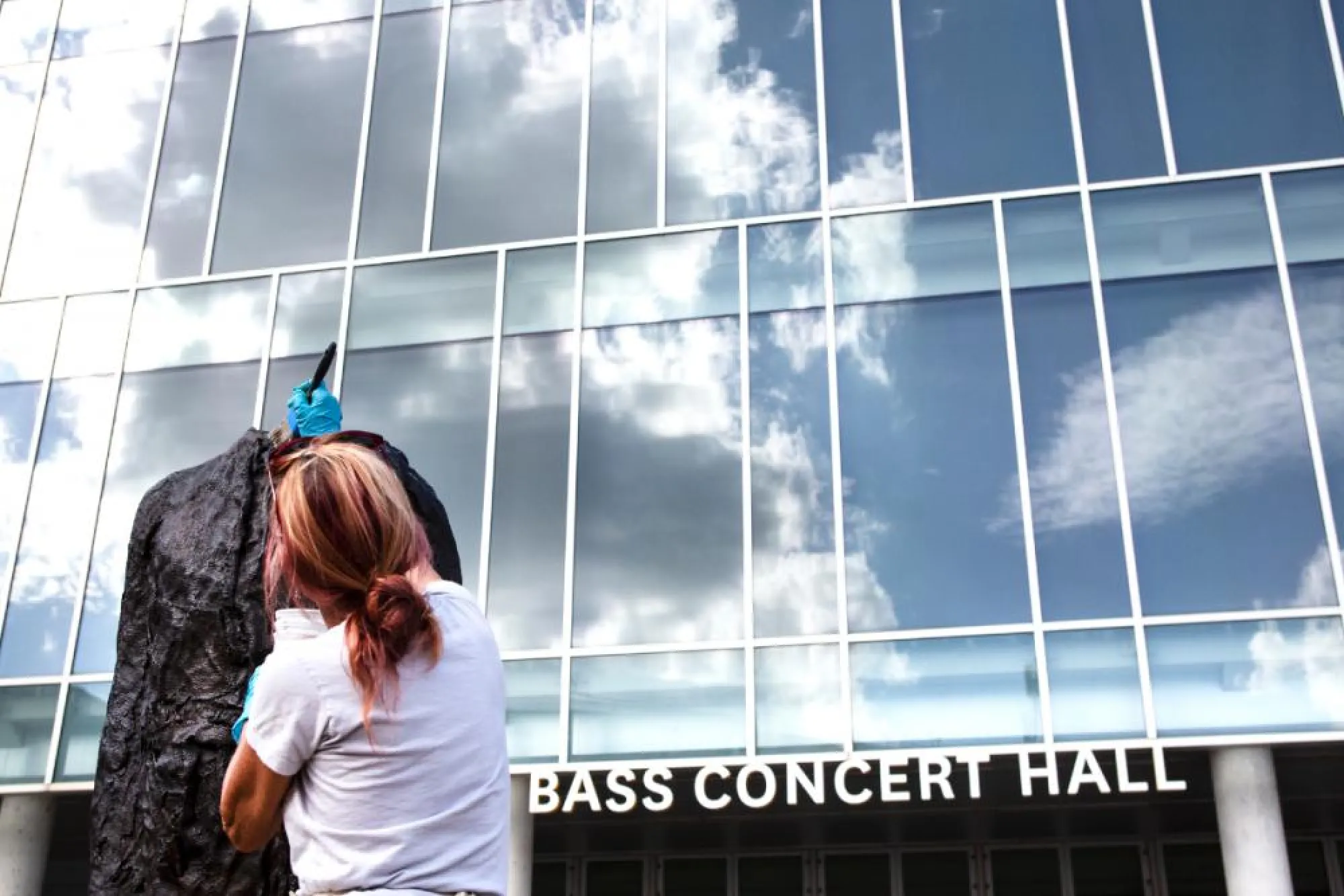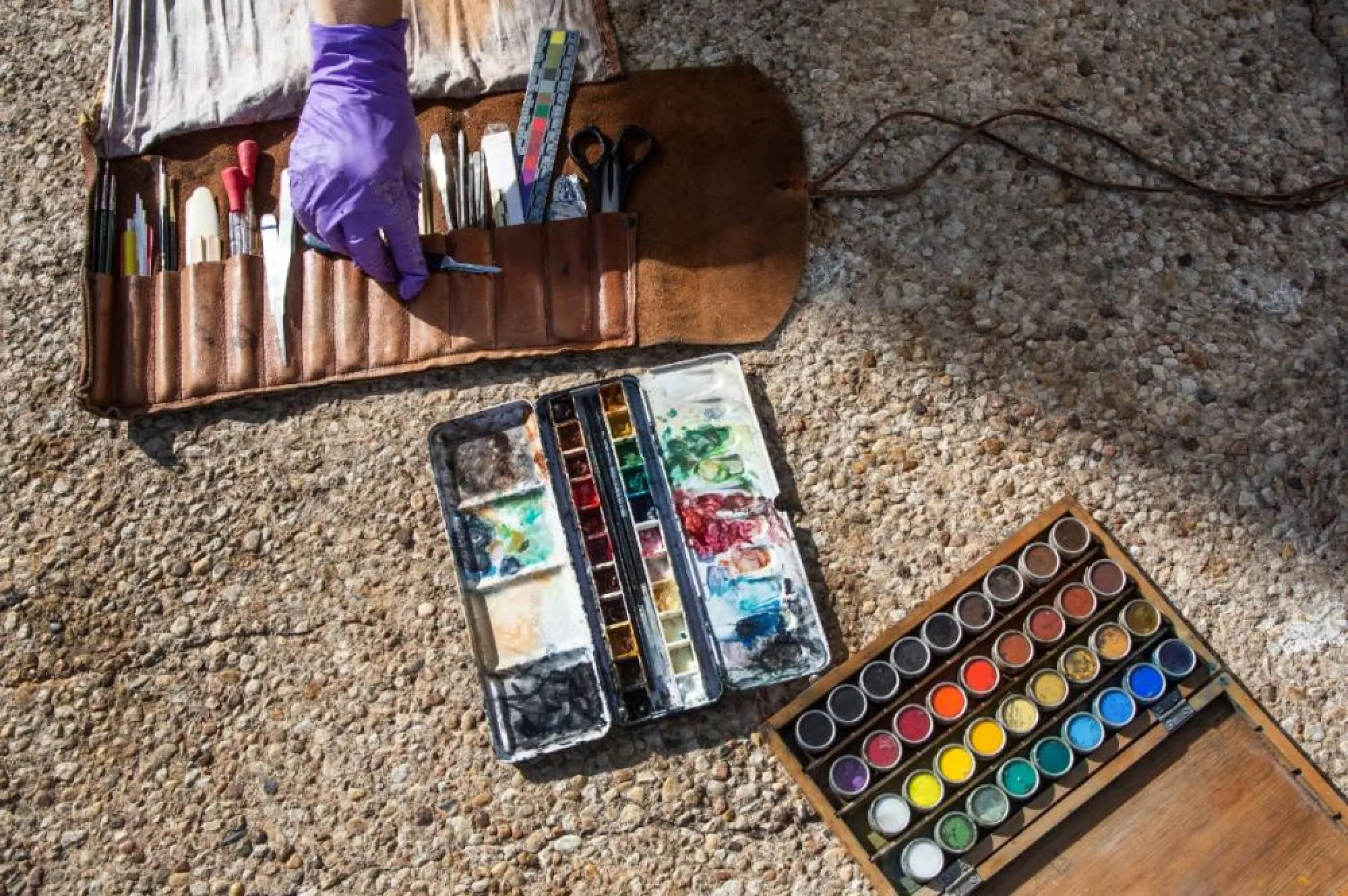Safeguarding UT’s Art Treasures

by Rebecca Johnson
Since its inception in 2008, Landmarks, the university’s public art program, has continued to grow. Today, it comprises more than 40 large-scale sculptures, murals and other works spanning the campus. From monumental outdoor sculptures such as Mark di Suvero’s Clock Knot, which brings fire-engine-red drama to a cluster of nondescript engineering buildings, to intimate indoor works gracing the halls of Bass Concert Hall, all of these works need love and care.
A group of mostly student volunteers has helped look after the works, while at the same time learning about careers in the arts. The Landmarks Preservation Guild (LPG) came about soon after the first set of Landmarks pieces, a long-term loan of 28 sculptures from the Metropolitan Museum of Art, arrived on campus.
“These large-scale sculptures were intended for outdoor, or very large indoor, spaces, which we do not have in New York,” said Met curator Gary Tinterow at the time. “With the loan of the works to Austin, they will be enjoyed by thousands of university students, staff and visitors to the university.”
The massive loan was a new concept. “The Metropolitan had never made such a large-scale, long-term loan to anyone before,” says Catherine Williams, professional art conservator and owner of Silver Lining Art Conservation in Austin. The museum stipulated that regular care from a conservator be part of the loan agreement. The university contracted with Williams, beginning a relationship that has spanned more than a decade.
In Landmarks’ earliest days, says Nisa Barger, Landmarks’ assistant director for collections, curators “realized it would be great to have additional eyes and ears on the ground to help monitor the works and make sure that the standards we want for exhibition quality are adhered to.”
This need for extra help fit perfectly with another idea welling up at that time: to use the sculptures as outdoor teaching tools.
“I thought it would be great to create volunteer opportunities for students to get hands-on experience caring for the sculptures,” Williams says, “as well as provide learning opportunities about conservation. And just open it up to anyone in the university at any level.” Thus, the idea for LPG was born.
The group numbers 18 this year, but membership numbers vary from one year to the next. Barger estimates LPG has had 150 volunteers over 10 years. Most are UT Austin undergraduates, with some exceptions. “We get a lot of people from all kinds of disciplines,” Williams says, citing arts administrators, artists and city planners. UT staff members have also participated.
Each year the volunteers start with training. In the first of two one-hour sessions, Williams teaches them how to complete a condition report, the key task of their volunteer work. This involves inspecting the work while comparing it to a photograph and noting any damage, weathering or other changes. Next, she introduces the volunteers to their tools and materials and teaches them how to wash and wax sculptures. Wax coatings protect the pieces from the elements and graffiti. Other types of training have included applying drying oil to steel, grouting concrete, tracking wood cracks and studying patination, Williams says.

In general, Barger says, volunteers handle simple conservation tasks while Williams tackles the more in-depth work. However, from time to time, more advanced volunteers assist with projects such as matching paint colors used on works to prepare for future restoration, or testing which types of coatings will best protect certain works.
Volunteers also get a crash course in the ethics of conservation.
“Which in a nutshell is: Do as little intervention as possible, and make sure what you’re doing is reversible and in keeping with the artist’s intention,” Barger explains.
Once this training is over, each volunteer is assigned a piece in the Landmarks collection that he or she checks on once or twice per month and reports back on.
Erin Coupal volunteered with the guild from 2012 to 2015. Today, she is registrar at The Contemporary Austin, which means she deals with “the logistics of artwork objects.”
Her work includes everything from insurance to collection inventories, maintenance, writing contracts for commissioned works and handling copyright issues.
During her time with LPG, Coupal was assigned the Joel Perlman sculpture Square Tilt, which sits on the plaza in front of the Perry-Castañeda Library (PCL). One of her primary tasks was cleaning the piece, which led to some funny moments.
“There was this — I never saw it, but there was a bird of prey that kept landing on it, and pooping all over it,” she says, laughing. Dealing with that unglamorous side of art maintenance turned out to be good training, though. Even now, she explains, she has to cope with what professionals euphemistically call “bird accretions” in her responsibility for the sculptures at The Contemporary.
“It gave me an introduction into this funny world of artwork maintenance,” Coupal says. “Whoever thinks of that as a job?”
Additionally, she says, volunteering with LPG helped her understand when an intervention on an artwork was too much.
“If I accidentally damage a sculpture, thinking that I was trying to fix it, [that] completely goes against my whole intention of protecting the integrity of artists and artworks.”
Coupal has been with The Contemporary since 2015. She completed a degree in Art History during the same year.
Desirae Dijkema is another LPG alum — one of the first. Today, she is an assistant paintings conservator at The Menil Collection in Houston.
During her time with LPG, Dijkema recalls a group project on the Donald Lipski sculpture The West, located near the UT Tower. The sculpture is covered in pennies, she explains, and the LPG volunteer assigned to monitor it kept finding pennies sitting on its base.
“The question became: Is this penny original, or is this penny a penny that somebody just put on the base of the sculpture?” she says.
It was a more important question than it seems. Williams explained to Dijkema and the other volunteers that pennies of different eras have different compositions and corrode differently. Putting the wrong pennies back on the sculpture could, over time, create patterns on its surface that the artist did not intend.
“Such a simple question,” says Dijkema, “actually brought about all of these other, more complex questions.”
Today, though trained in conserving paintings across many periods, Dijkema works mainly with modern and contemporary art, which she says is her great love. Prior to taking up her position at The Menil in November, Dijkema was a conservation fellow at the San Francisco Museum of Modern Art.
“One of the reasons that I enjoyed working in Landmarks so much was that it was largely modern and contemporary art,” she says.
Dijkema graduated from UT in 2010 with degrees in Art History and Spanish, and she went on to pursue a master’s in Art History, with an advanced certificate in art conservation from New York University.
“Most directly the way that [LPG] helped me was that it fulfilled one of the prerequisites for graduate school,” she says, explaining that most conservation graduate programs require applicants to have previous hands-on experience. And that’s often really difficult to come by. It’s not just about being in the studio, but often the programs want to see treatment — actually working on an artwork. ‘What sort of treatment did you do? How did it work out? What did you use and why did you use it?’ Landmarks was, from that respect, such a gift.”
In addition to learning how to monitor and treat artworks, volunteers willing to put in extra time can learn even more from LPG. Each year Barger organizes a series of optional workshops.
“We try to make it a meaningful experience for them,” Barger says. During the fall, she planned a workshop with a paper conservator, a tour of the conservation department at the Harry Ransom Center and a behind-the-scenes tour of a local fine art handling and storage facility. Past activities have included visits to the Prints and Drawings archive at the Blanton Museum, a trip to a foundry to witness bronze casting of sculptures and workshops with art collections managers, art handlers and curators.
“I was going to all of that,” The Contemporary’s Coupal remembers of the additional training opportunities, “just because I was so fascinated with everything that it takes to maintain an artwork collection, especially an outdoor sculpture collection. That’s something that is very specific to Landmarks and The Contemporary: outdoor sculpture.”

Several LPG volunteers have gone on to careers in art conservation and related fields. In addition to The Contemporary Austin and The Menil Collection, former volunteers also work at the Dallas Museum of Art and the Nasher Sculpture Center in Dallas. They work in fields as diverse as art conservation, curation, membership and public relations.
“I think that it is pretty unique,” Coupal says of LPG. “It was a great program, and I’m glad I found it.”
Rebecca Johnson is an Austin-based arts writer.

